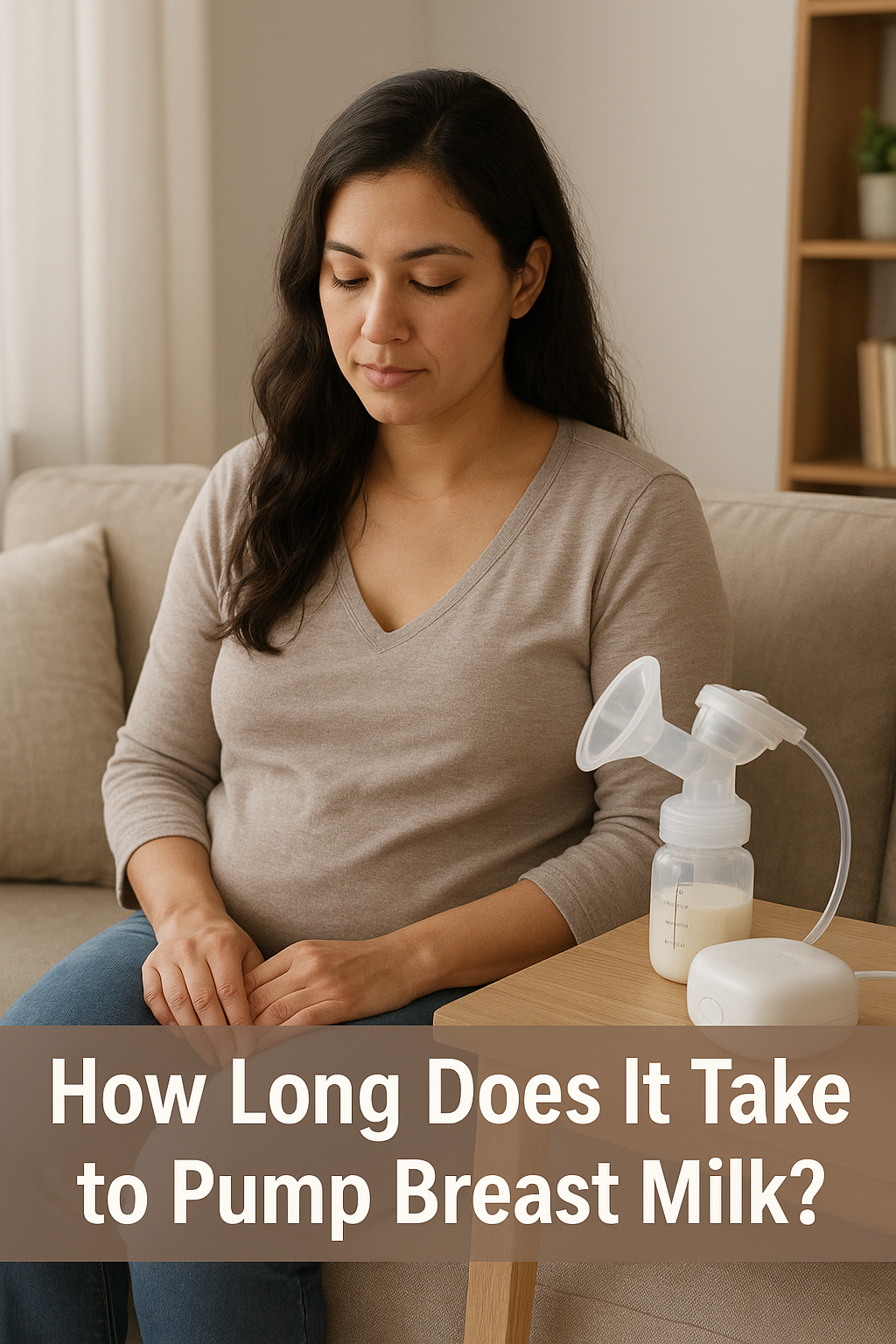
How Long Does It Take to Pump Breast Milk?
Share
Breastfeeding mothers often wonder how long it takes to pump breast milk effectively. Whether you’re returning to work, building a freezer stash, or exclusively pumping, understanding your pumping duration, breast milk flow, and lactation routine is essential for maintaining a steady milk supply.
In this detailed guide, we’ll cover everything you need to know about pumping—from average times and influencing factors to efficient pumping tips and scheduling for busy moms.
Understanding the Basics of Breast Pumping
Before discussing how long it takes, it’s important to understand what pumping really involves.
Pumping breast milk is the process of expressing milk from your breasts using a manual or electric breast pump. It allows mothers to collect and store milk for later feeding, providing flexibility while maintaining their milk supply.
Each mother’s body is unique, so breast milk flow and pumping efficiency can vary widely. The time it takes to express milk depends on your baby’s feeding pattern, pump quality, and comfort level during each session.
Average Pumping Duration
On average, a pumping session takes 15 to 30 minutes per breast, depending on the pump type and your milk flow.
Here’s a quick breakdown:
-
Electric double pumps: Around 15–20 minutes total.
-
Manual pumps: 20–30 minutes or longer.
-
Hospital-grade pumps: Usually 10–15 minutes due to better suction.
For most mothers, it takes about 15 minutes for the letdown reflex to start and milk to flow consistently. However, every woman’s pumping duration differs, especially during the first few weeks of breastfeeding.
Factors That Affect Pumping Time
Several factors influence how long you’ll need to pump:
1. Breast Milk Flow
Your natural milk flow plays a big role. Mothers with faster letdowns may finish pumping in less time. Others may need extra minutes to trigger multiple letdowns.
2. Pump Type and Efficiency
A high-quality electric or hospital-grade pump can cut your pumping time significantly. If you’re using a manual pump, it may take longer because of the need for hand control and pressure adjustments.
3. Lactation Routine and Consistency
A consistent lactation routine trains your body to produce and release milk at predictable times. Irregular pumping can delay letdowns or reduce output.
4. Time of Day
Morning sessions typically yield more milk in less time, as breasts are fuller after nighttime rest. Evening sessions may take longer due to reduced supply.
5. Hydration and Nutrition
Proper hydration and nutrition directly affect breast milk flow. Dehydration or fatigue can slow pumping efficiency.
6. Stress Levels
Stress and anxiety can delay milk letdown, increasing overall pumping duration. Creating a calm, comfortable space helps milk flow naturally.
Setting the Right Pumping Schedule
Creating a reliable pumping schedule is key to maintaining your supply and minimizing long sessions.
A good starting routine might look like this:
-
Newborn stage (0–3 months): Pump every 2–3 hours, including overnight.
-
Infant stage (3–6 months): Pump every 3–4 hours.
-
Established supply (6+ months): Pump every 4–5 hours or as needed.
If you’re exclusively pumping, you’ll likely spend 2–3 hours total per day across all sessions.
For personalized schedules, consider visiting Wonder Bewbz for products and resources that support efficient pumping and milk storage.
How to Know When to Stop Pumping
Many mothers wonder, “How do I know when to stop?”
Here are signs your session is complete:
-
Milk flow slows to a few drops.
-
Breasts feel softer and less full.
- No further letdowns occur even with breast compression.
Avoid over-pumping, as it can cause nipple soreness or engorgement. Stopping when your breasts feel comfortably empty is sufficient.
Efficient Pumping Tips for Busy Moms
Balancing motherhood and work can make pumping time challenging. Try these efficient pumping tips to make every session count:
-
Use a Double Pump: Saves time by expressing milk from both breasts simultaneously.
-
Massage Before Pumping: Stimulates milk flow and improves output.
-
Relax During Pumping: Listening to soothing music or looking at your baby’s photos can trigger letdown.
-
Warm Compress: Applying a warm compress before pumping can enhance milk release.
-
Check Pump Parts: Ensure all parts are assembled correctly and suction is adequate.
- Track Sessions: Note down timings and milk quantity to understand your best pumping windows.
How to Build a Pumping Routine That Works
Your lactation routine should align with your lifestyle and your baby’s feeding needs.
Start by:
-
Pumping after feeding: Ideal for building stash without overstimulating supply.
-
Sticking to consistent times: Helps regulate milk production.
-
Avoiding long gaps: Skipping sessions can reduce supply.
If you struggle with low output, see this helpful guide on How to Increase Breast Milk Supply.
How to Store Expressed Milk Safely
After each session, store your milk safely to preserve its nutrients and freshness.
-
Room temperature: 4–6 hours (in clean conditions).
-
Refrigerator: 4–5 days.
-
Freezer: 3–6 months depending on freezer type.
For detailed safety instructions, visit How Long Can Breast Milk Last in the Fridge.
Pumping Duration During Different Stages of Lactation
Pumping needs evolve as your baby grows.
|
Stage |
Average Duration |
Frequency |
Notes |
|
Newborn |
20–30 minutes |
8–10 times/day |
Frequent pumping to build supply |
|
3–6 months |
15–25 minutes |
6–8 times/day |
Maintain a steady flow |
|
6–12 months |
15–20 minutes |
4–6 times/day |
Milk volume stabilizes |
|
Beyond 1 year |
10–15 minutes |
2–3 times/day |
Supply naturally tapers off |
Your pumping time shortens as your body becomes more efficient and your breast milk flow adapts to your baby’s needs.
Common Pumping Challenges and Solutions
Even experienced moms face obstacles. Here’s how to overcome common pumping issues:
1. Slow Milk Flow
Use warm compresses, gentle massage, and hydration to improve flow.
2. Low Output
Check flange size and ensure proper suction. You can also add a power-pumping session once daily to boost supply.
3. Pain or Discomfort
Pain indicates an improper fit or suction level. Adjust your pump settings and ensure nipples are centered.
4. Leaking or Milk Loss
Invest in quality storage bags and secure sealing methods. Refer to Breast Milk Freezer Guide for best practices.
Nutrition and Hydration Tips for Better Pumping
A healthy diet supports better milk output and shorter pumping sessions. Include:
-
Oats, fenugreek, fennel seeds
-
Whole grains, leafy greens, and almonds
-
Hydrating fluids like water, coconut water, and herbal teas
Check out this article on Foods to Increase Breast Milk for more guidance.
When Pumping Feels Too Time-Consuming
If you’re spending long hours pumping with limited output, you’re not alone. Many mothers experience this due to hormonal shifts, stress, or poor pump performance.
Consider trying freeze-dried breast milk options that preserve nutrients and are perfect for travel. Learn more about Freeze-Dried Breast Milk Powder.
Balancing Pumping and Everyday Life
Combining work, baby care, and pumping can feel overwhelming. Here’s how to manage:
-
Set reminders for sessions.
-
Create a comfortable pumping space.
-
Label and organize stored milk.
-
Keep pump parts clean and dry.
Regular breaks and emotional support are equally vital for your well-being.
Tips for Returning to Work While Pumping
Returning to work requires planning to sustain your milk supply.
-
Pump before leaving home.
-
Store milk in insulated coolers.
-
Communicate with your employer about breaks for pumping.
-
Use a portable or wearable pump for convenience.
A consistent pumping schedule ensures your baby receives fresh milk even while you’re away.
How to Maintain Milk Supply While Pumping
To keep your supply steady:
-
Pump frequently.
-
Stay hydrated.
-
Eat lactation-friendly foods.
-
Avoid long gaps between sessions.
- Power pump when needed.
Tracking Your Pumping Progress
Documenting your daily pumping details helps you see patterns and improvements.
-
Time of each session
-
Volume expressed
-
Duration
-
Mood or comfort level
You can also use the Baby Milk Calculator to estimate your child’s daily milk needs.
Conclusion
Every mother’s pumping duration is unique. On average, expect to spend about 15–30 minutes per session, adjusting as your supply stabilizes. Remember, consistency, comfort, and patience are key to maintaining an effective lactation routine.
With the right pumping schedule and efficient pumping tips, you can make the process smoother and more rewarding while ensuring your baby receives the nourishment they need.
For more expert guidance and lactation-friendly resources, visit Wonder Bewbz — your trusted source for breast milk storage, supply tips, and freeze-dried milk solutions.
Frequently Asked Questions
How long does it take to pump 4 ounces of breast milk?
It usually takes 15–20 minutes, depending on your milk flow, pump efficiency, and hydration level.
How many times a day should I pump to maintain my supply?
Most mothers need to pump 6–8 times daily to mimic a baby’s feeding pattern and maintain milk production.
Can I pump too long?
Yes. Over-pumping can lead to nipple soreness or oversupply. Stop once milk flow slows and breasts feel soft.
How can I make pumping faster?
Use a double electric pump, massage your breasts before pumping, and ensure proper flange fit to reduce time.
What is the best time of day to pump?
Morning sessions are ideal because milk supply is often higher after a full night’s rest.
Why does my pumping output vary daily?
Daily fluctuations are normal and influenced by hydration, stress, and diet.
Can I combine milk from different sessions?
Yes, but cool freshly pumped milk before mixing with refrigerated milk.
How much milk should I get from each pumping session?
New mothers may get 1–2 ounces per session initially. With time, many produce 3–5 ounces or more.
Does pumping hurt?
It shouldn’t. Pain indicates improper suction or flange size. Adjust settings for comfort.
How can I improve my letdown reflex?
Relaxation, gentle breast massage, warmth, and deep breathing can help trigger faster letdown.
